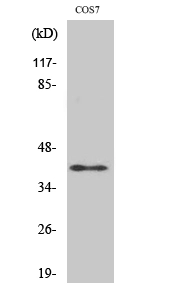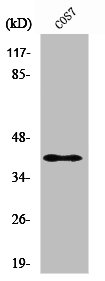
WB analysis of HeLa lysate using GTX89889 Rad51C antibody, N-term. Dilution : 2microg/ml Loading : 30microg protein in RIPA buffer
Rad51C antibody, N-term
GTX89889
Overview
- SupplierGeneTex
- Product NameRad51C antibody, N-term
- Delivery Days Customer9
- Application Supplier NoteWB: 1-3microg/ml. *Optimal dilutions/concentrations should be determined by the researcher.Not tested in other applications.
- ApplicationsWestern Blot
- CertificationResearch Use Only
- ClonalityPolyclonal
- Concentration0.50 mg/ml
- ConjugateUnconjugated
- Gene ID5889
- Target nameRAD51C
- Target descriptionRAD51 paralog C
- Target synonymsBROVCA3; DNA repair protein RAD51 homolog 3; FANCO; R51H3; RAD51L2; RAD51-like protein 2; yeast RAD51 homolog 3
- HostGoat
- IsotypeIgG
- Protein IDO43502
- Protein NameDNA repair protein RAD51 homolog 3
- Scientific DescriptionThis gene is a member of the RAD51 family. RAD51 family members are highly similar to bacterial RecA and Saccharomyces cerevisiae Rad51 and are known to be involved in the homologous recombination and repair of DNA. This protein can interact with other RAD51 paralogs and is reported to be important for Holliday junction resolution. Mutations in this gene are associated with Fanconi anemia-like syndrome. This gene is one of four localized to a region of chromosome 17q23 where amplification occurs frequently in breast tumors. Overexpression of the four genes during amplification has been observed and suggests a possible role in tumor progression. Alternative splicing results in multiple transcript variants. [provided by RefSeq, Jul 2013]
- Storage Instruction-20°C or -80°C,2°C to 8°C
- UNSPSC12352203


![WB analysis of (1) HeLa, (2) HepG2, (3) COS-7, and (4) HEK293 cell lysate using GTX30137 Rad51C antibody [2H11/6].](https://www.genetex.com/upload/website/prouct_img/normal/GTX30137/GTX30137_1341_WB_w_23060722_219.webp)





